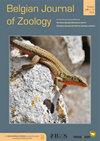Comparison of isotopic niches of four sea cucumbers species (Holothuroidea: Echinodermata) inhabiting two seagrass meadows in the southwestern Mediterranean Sea (Mostaganem, Algeria)
IF 1.3
4区 生物学
Q2 ZOOLOGY
引用次数: 8
Abstract
Among the fauna inhabiting the Posidonia oceanica seagrass meadow, holothurians are particularly abundant and provide essential ecological roles, including organic matter recycling within seagrass sediments. This study aimed to investigate the trophic niche of four holothurians of the order Holothuriida [Holothuria poli (Delle Chiaje, 1824), Holothuria tubulosa (Gmelin, 1791), Holothuria sanctori (Delle Chiaje, 1823) and Holothuria forskali (Delle Chiaje, 1823)] inhabiting P. oceanica meadows, through the measurement of nitrogen and carbon stable isotope ratios. Two shallow and contrasting sites of the littoral region of Mostaganem (North West Algeria) were chosen. The first site, located in Stidia, is weakly impacted by human activities. The second site, located in Salamandre, is highly impacted by human activities (industries, harbor facilities). High values of δ15N in holothurians and their food sources were observed at both sites. The δ13C values showed a lower contribution from detritic Posidonia than in other areas. This could be a consequence of P. oceanica bed degradation in the studied area. The stable isotope approach did not reveal dietary differences between species, and the four holothurians species exhibited significant isotopic niche overlap. However, niche sizes differed between species showing more variable individual trophic diversity in some species (H. tubulosa and H. sanctori in Salamandre; H. forskali in Stidia). If niche segregation does occur, it is not in terms of general resource use. More likely, it would be the abundance of food sources, the different life habits and their micro-habitats that may explain their co-existence in the P. oceanica seagrass meadow.阿尔及利亚Mostaganem地中海西南部两个海草草地上4种海参(holothuro总科:棘皮科)同位素生态位的比较
在Posidonia oceanica海草草甸的动物群中,holothurian数量尤其丰富,并在海草沉积物中的有机物循环等方面发挥着重要的生态作用。本研究旨在通过测定氮和碳稳定同位素比值,研究海洋草甸中4种Holothuria [Holothuria poli (Delle Chiaje, 1824)、Holothuria tubulosa (Gmelin, 1791)、Holothuria sanctori (Delle Chiaje, 1823)和forskali Holothuria forskali (Delle Chiaje, 1823)]目Holothuria的营养生态位。选择了Mostaganem(阿尔及利亚西北部)沿海地区的两个浅层和对比鲜明的地点。第一个地点位于Stidia,受人类活动的影响很小。第二个地点位于Salamandre,受到人类活动(工业,港口设施)的高度影响。在这两个地点均观察到海参及其食物源中δ15N的高值。δ13C值表现为碎屑Posidonia的贡献小于其他地区。这可能是研究区域海洋藻床退化的结果。稳定同位素方法未发现物种间的饮食差异,4种海龙的同位素生态位有明显重叠。然而,物种间生态位大小存在差异,个别物种的个体营养多样性变化较大(蝾螈属的管状鼩鼱和桑托里鼩鼱);在Stidia的H. forskali)。如果生态位隔离确实发生,那也不是在一般资源利用方面。更有可能的是,丰富的食物来源、不同的生活习惯和它们的微栖息地可能解释了它们在大洋藻海草草甸上的共存。
本文章由计算机程序翻译,如有差异,请以英文原文为准。
求助全文
约1分钟内获得全文
求助全文
来源期刊

Belgian Journal of Zoology
生物-动物学
CiteScore
1.90
自引率
0.00%
发文量
10
审稿时长
>12 weeks
期刊介绍:
The Belgian Journal of Zoology is an open access journal publishing high-quality research papers in English that are original, of broad interest and hypothesis-driven. Manuscripts on all aspects of zoology are considered, including anatomy, behaviour, developmental biology, ecology, evolution, genetics, genomics and physiology. Manuscripts on veterinary topics are outside of the journal’s scope. The Belgian Journal of Zoology also welcomes reviews, especially from complex or poorly understood research fields in zoology. The Belgian Journal of Zoology does no longer publish purely taxonomic papers. Surveys and reports on novel or invasive animal species for Belgium are considered only if sufficient new biological or biogeographic information is included.
 求助内容:
求助内容: 应助结果提醒方式:
应助结果提醒方式:


